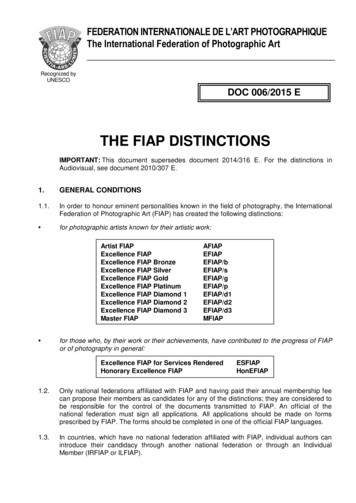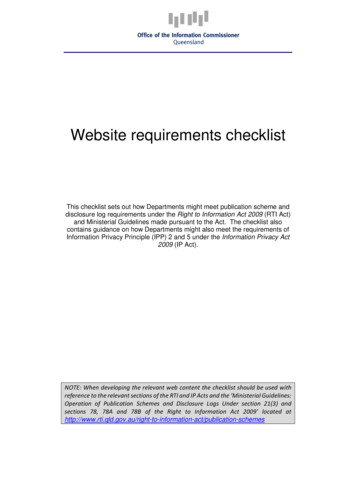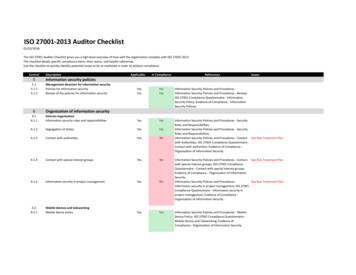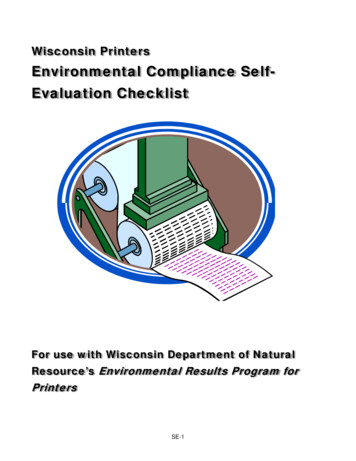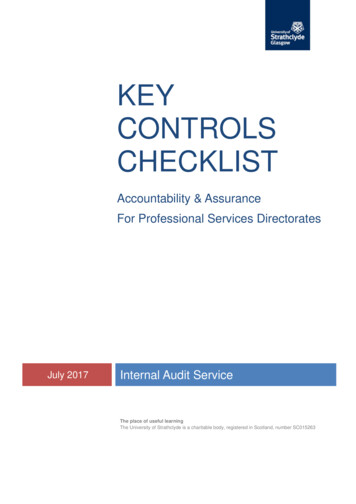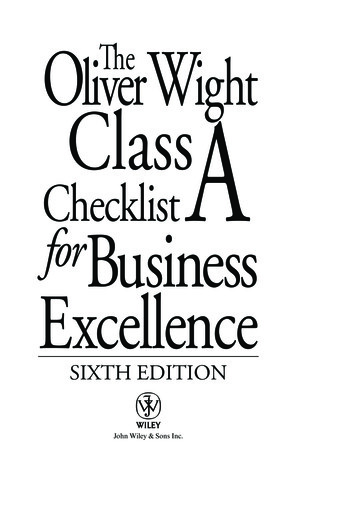
Transcription
TheOliverWightClassAChecklistfor BusinessExcellenceSIXTH EDITIONJohn Wiley & Sons Inc.
Class A Business ExcellenceFor Managing the Strategic Planning Process Managing and Leading People Driving Business Improvement Integrated Business Management Managing Products and Services Managing Demand Managing the Supply Chain Managing Internal Supply Managing External Sourcing
TheOliverWightClassAChecklistfor BusinessExcellenceSIXTH EDITIONJohn Wiley & Sons Inc.
Copyright 2005 by Oliver Wight International. All rights reserved.Published by John Wiley & Sons, Inc., Hoboken, New Jersey.Published simultaneously in Canada.No part of this publication may be reproduced, stored in a retrieval system, or transmitted inany form or by any means, electronic, mechanical, photocopying, recording, scanning, orotherwise, except as permitted under Section 107 or 108 of the 1976 United States CopyrightAct, without either the prior written permission of the Publisher, or authorization throughpayment of the appropriate per-copy fee to the Copyright Clearance Center, Inc., 222Rosewood Drive, Danvers, MA 01923, (978) 750-8400, fax (978) 646-8600, or on the web atwww.copyright.com. Requests to the Publisher for permission should be addressed to thePermissions Department, John Wiley & Sons, Inc., 111 River Street, Hoboken, NJ 07030,(201) 748-6011, fax (201) 748-6008, or online at http://www.wiley.com/go/permissions.Limit of Liability/Disclaimer of Warranty: While the publisher and author have used theirbest efforts in preparing this book, they make no representations or warranties with respectto the accuracy or completeness of the contents of this book and specifically disclaim anyimplied warranties of merchantability or fitness for a particular purpose. No warranty maybe created or extended by sales representatives or written sales materials. The advice andstrategies contained herein may not be suitable for your situation. The publisher is notengaged in rendering professional services, and you should consult a professional whereappropriate. Neither the publisher nor author shall be liable for any loss of profit or anyother commercial damages, including but not limited to special, incidental, consequential,or other damages.For general information on our other products and services please contact our CustomerCare Department within the United States at (800) 762-2974, outside the United States at(317) 572-3993 or fax (317) 572-4002.Wiley also publishes its books in a variety of electronic formats. Some content that appearsin print may not be available in electronic books. For more information about Wileyproducts, visit our web site at www.Wiley.com.Library of Congress Cataloging-in-Publication Data:The Oliver Wight Class A checklist for business excellence / Oliver Wight International,inc.—6th ed.p. cm.—(Oliver Wight manufacturing series)Rev. ed. of: Oliver Wight ABCD checklist for operational excellence. 5th ed. 2000.Published simultaneously in Canada.Includes bibliographical references.ISBN-13 978-0-471-74106-0 (pbk.)ISBN-10 0-471-74106-X (pbk.)1. Industrial productivity—Measurement. 2. Strategic planning. 3. Total qualitymanagement. 4. Manufacturing resource planning. 5. Production control. I. Wight,Oliver W. II. Oliver Wight International, inc. III. Oliver Wight ABCD checklist foroperational excellence. IV. Series.HD56.25.O38 2005658.4 013—dc222005003952Printed in the United States of America10 9 8 7 6 5 4 3 2 1
CONTENTSPREFACEviINTRODUCTIONixFOUNDATIONxivHOW TO USE THE CHECKLISTxxi1. MANAGING THE STRATEGIC PLANNING PROCESS12. MANAGING AND LEADING PEOPLE213. DRIVING BUSINESS IMPROVEMENT474. INTEGRATED BUSINESS MANAGEMENT(SALES & OPERATIONS PLANNING)755. MANAGING PRODUCTS AND SERVICES1016. MANAGING DEMAND1237. MANAGING THE SUPPLY CHAIN1478. MANAGING INTERNAL SUPPLY1699. MANAGING EXTERNAL SOURCING193OLIVER WIGHT BIOGRAPHY213Additional clarification can be obtained from the Oliver Wight International website(www.oliverwight.com) where a glossary can be found and the metrics to supportPerformance Measures.v
PREFACEWelcome to the sixth edition of the Oliver Wight Class A Checklist forBusiness Excellence, which marks another major milestone on a journeystarted by Oliver Wight himself in the 1970s. His passion was to supportcompanies seeking to be consistent winners by aspiring to excellence.This new Checklist is the comprehensive statement of excellence in business today.It looks very different from our last version, with its scope widened toembrace every part of the business to be pursued for total excellence.Additionally, it now requires a demonstrated superior business performance for the coveted Class A award. However the major features remain and are unique. It is direct and practical. It does not follow the trend of setting theoretical business models for you to “fill in.” It sets out those business processes and practices that we see over and over at the heartof successful and excellent businesses. Its chapters align with core business processes and the enablers ofthose processes, covering the entire Business. It is aimed so that your people can see for themselves what “excellence” is and what each of them has to do for the company to be excellent. Its scoring method allows you to visualize and measure progresstowards excellence in every part of the Business.The sixth edition offers the longest standing Excellence Award of international repute. It recognizes the efforts of your people and can beused with clients and customers to prove your efforts on their behalf.The first checklist in 1977 was a simple list of 20 questions that a manager could answer to evaluate his business. It was the very first such listin the world and, consequently, the checklist concept became widely acvi
Prefaceviicepted. However, standards of excellence in business had started theirown revolution. As a result, the list went from one page to a book, witheach version building on the last. The questions were built from the accumulated experience of Oliver Wight’s organization throughout the worldand from the many people they worked with in thousands of companies.The first checklist book was published in 1988 and was a major statement in defining excellent use of Manufacturing Resource Planning(MRPII) systems, continuous improvement processes and the realization of sustainable processes. The fourth edition followed in 1993 andthe fifth some seven years later in 2000. With each edition, the standardfor excellence increased, and the scope of the business that was assessedwidened as the world became evermore competitive and companies became larger and more international.Throughout this adventure some things are unchanged: The Oliver Wight International organization continues to grow andset the standards in global business excellence. It operates throughout the world offering the same message inmany languages for its multinational and multicultural client base. It holds to the same core belief that education and training at alllevels of the company are the keys to achieving excellence. One other thing that remains unchanged is the role and purpose ofthis checklist.Many have contributed to the know-how in this book, but we mustrecognize some people who have been major contributors. The book has been sponsored by the Oliver Wight InternationalBoard, and its development was led by Andrew Purton as its champion. The checklist architect, Lawrie Rumens, has brought his experienceand expertise to the design forum to steer the journey to a superiorClass A. The project leader, Lloyd Snowden, has spent so much time andenergy driving very busy people and has delivered the book on time. Glyn Williams and Jon Minerich provided the global leadership. Each chapter had its own champion and sponsor supported by expert teams from the other regions. The chapters were led by LawrieRumens, Peter Hill, Andrew Purton, Les Brookes, Kevin Herbert,Liam Harrington, Ron Ireland, Rod Hozack, and Barry Linger.
viii PrefaceChris Radford, Paul Archer, and Shirley Harrison also generouslycontributed. Last, where would we be without Jill Losik pulling it and us together in such an uncomplaining way?So here is the sixth edition Checklist. It is no longer an MRP checklist or a manufacturing excellence standard. It is a standard of excellence for all businesses. We know that you will find it demanding, butthen true excellence never did come easy. It will be rewarding as well.True excellence is the only way of consistently and reliably competingand winning in business. That’s what Oliver Wight Class A is about,helping you to be in a position to win consistently in your business.For those executives anxious to take up the challenge of raising theircompany’s performances to heights of excellence, this Checklist willshow them the way.Walt GoddardChairman Emeritus,Oliver Wight International, Inc.
INTRODUCTIONThose of you familiar with the Oliver Wight checklist over a period oftime will view this updated version with anticipation and perhaps a littlenervousness. We have all experienced the moments before we open anexamination paper when we are convinced that we will not be able to answer a single question adequately. Yet once we are into it, we find that ofcourse it all makes sense. It is not so daunting when we make a start.This sixth edition of the renowned Oliver Wight Class A Checklist forBusiness Excellence has a familiar style and approach to assessing excellence. Yet in content and structure you will find it very different andmuch more demanding—but then the journey to excellence is alwaysdemanding. Since we published the fifth edition in the year 2000, thepace of change and speed of advancement in business has raced on.What seemed advanced then is ordinary today; what was extra then is apart of the standard deal now; and customers expect and demand moreand more. Companies clinging to that older view of excellence will befound wanting in the race to win in business.WHAT IS DIFFERENT IN THIS SIXTH EDITION?First, there is a new section at the front of the book called “Foundation.” We had to decide at the outset what few basic principles of excellence were important enough to be at the heart of the checklist. We havedescribed these here in brief so that you can be familiar with the thinking before plunging into the detailed assessment. Clearly, we have onlyprovided an overview of these principles in this section. However, youcan find out more through Oliver Wight’s global education.Second, the checklist range has been extended from a traditionalix
xIntroductionoperational focus to encompass all business processes and all businesssectors. This will be no surprise, since across the world service sectorsare growing and are influencing the traditional industries. Business differentiators are moving to managing products and services, managingthe supply chain, managing the procurement of externally sourced items,and developing better relationships with customers and consumers. Allof these issues are now extensively covered alongside the more traditional foundation elements you would expect to find in this checklist.THE CHAPTERSThe chapters are split into two groups. There are four priority chapters where we have brought together the processes and practices that arecommon through all business processes and which enable the wholebusiness to be excellent. They are: Managing the Strategic Planning Process: You have to be clearabout business vision and strategy for your people to plan what has tobe done to get there. This chapter will challenge your process for thelonger term planning of the business. It will demand the setting of business priorities and clear communication when deploying your plans andyour business excellence program throughout the business. Managing and Leading People: People are the ultimate differentiator as businesses get more demanding and competitive. This chapterwill demand that you think through your business values and its organization for the tasks ahead, that you are clear about the company cultureand behaviors that you need, and that you have active development programs designed to improve the competencies of your people for the newchallenges ahead. It will challenge your processes for Knowledge Management and your culture of leadership and teamwork. Driving Business Improvement: This articulates how you can assessthe maturity of your business and its processes. It then challenges howyou prioritize your Business Improvement Program to the early gainsareas that also create a solid foundation for the future. This chapter willchallenge you to walk before you try to run and to give value to thoseeveryday issues that are at the heart of excellence in business. Integrated Business Management: This is the natural evolution ofthe Sales and Operations Planning process. It has been designed and developed by Oliver Wight over many years, building on client demands
Introductionxiand experiences in all sectors and in all parts of the world. This processis the unique, yet now standard, approach to managing the gap betweencompany strategic goals and everyday activity; it is the prime tool forkeeping all parts of the company to a common agenda and set of priorities; and it manages the entire business through one set of numbers andensures timely decisions to maintain management control.These chapters support five following chapters of equal size and importance that address the prime processes in most companies: Managing Products and Services: In every business sector, productlife cycles are reducing. Our portfolios require an increase in new products and services and a carefully planned phase-out of old. This chapterasks how well you set your product portfolio and manage products andservices. It expects you to have a clear technology strategy to supportthis. It challenges your practices for delivering sales and profit to yourbusiness through an increased number of successful products and services into your market. It includes the latest practices in the ProgramManagement of large complex projects. Managing Demand: Greater understanding of customer needs andof what is happening in your market place leads directly to increasedpredictability in the short-, medium-, and long-term needs of your business. It enables better planning of your position in the market place andorder-winning plans that are more successful. This chapter challengeshow well you create and plan demand and how professionally you control supply and demand in the very short term through sales activity. Managing the Supply Chain: As the latest technology extends ourtarget market, the increasing challenge to business is how to deliver theproduct and service to the point of use. This chapter challenges how wellyou understand your extended supply chain and how it is optimizedstrategically and day by day for best customer service and for businessperformance. Managing Internal Supply: While business focus is moving to theextended supply chain, excellence in the core supply activities remainsvital to live up to the promises and wishes of customers and consumersand to meet the challenge of global cost competition. This chapter challenges whether your operations that make and deliver goods and services understand what is excellent today and how quickly they mustrespond to changes and the demand of the market place. Managing External Sourcing: The increase in products and servicesand the wider market present new challenges to our Make/Buy decision
xii Introductionprocess at product, component, and material levels. They also impactthe sourcing strategies that follow those decisions. Technology offersnew procurement approaches that have major potential for saving, andthis has significantly advanced the use of Total Cost of Ownership incritical decision making. This chapter sets new standards for assessingexcellence in your procurement processes and in the planning and coordination of movement of goods into your supply chain.ADDITIONAL INFORMATIONYou may seek information from previous checklists that is no longerexpressed in this edition. To maintain a practical size Checklist with abroader base something had to give! However, this is not totally lost toyou. Clients of Oliver Wight have free access through their Oliver WightAssociate to supplements to these chapters. This is where we have captured the more detailed challenges from the fifth edition should yourprogram require them.MEASURESPrime performance measures are included at the end of each chapterof this Checklist, but we have not published the detailed appendices ofrecommended measures. In a fast-moving world, we wanted to be ableto update and add freely to these. So you will find them openly availableon our website at www.oliverwight.com, along with a new glossary thatis designed to take away the confusion of any new terminology. You willfind this approach more relevant to your business needs.RECOGNITION OF EXCELLENCELast, you will see a new scoring system, using a more natural 5-pointscale, and a new way of recognizing your steps toward excellence. Weare mindful that against a broader and higher standard it will take youlonger from the same starting point to achieve Class A Business Excellence in practices and performance than the previous checklist. As you
Introductionxiiistart this journey to excellence, we will invite you to set a total excellenceprogram with prioritized projects and initiatives, each giving you business gains in a relatively short timescale while taking you a step furthertoward your longer goals. Our recognition of your success will come inthree forms: Class A Business Excellence: The full Class A award when an entirebusiness meets the requirements of all chapters of this checklist. Business Unit Class A Accreditation: To recognize the achievementsof a stand-alone business within a larger multiunit business thatmeets all the requirements of its appropriate chapters. Class A Recognition Award: To recognize predetermined projectsand milestones in your business improvement program that havedelivered their planned business gains on the journey to Class ABusiness Excellences.The demands on a successful business are racing ahead, and withoutan aggressive excellence program, you will fall behind your competition. Your Business Improvement Program must be structured and targeted to deliver rewards for your customers and your owners. It is yourroute to winning consistently in business.
FOUNDATIONAs each day passes, companies in every sector of business get faster,smarter, and more innovative. In producing this latest version of our famedChecklist of Business Excellence, we have set a new Class A standard of excellence and established the basic principles that are important for a company to achieve outstanding performance today. This chapter of ourchecklist sets out those foundations and documents the main assumptionswe have made about practices and processes in excellent companies.ACHIEVING EXCELLENCEOur first assumption is that we are all in business to win: excellentcompanies win consistently and win more than their fair share. They setthe standards in their chosen markets and serve their customers betterthan the competition. They outperform the competition sufficiently todifferentiate. There is no point in any excellence program if it does notseriously deliver what the customer wants.Our second assumption is that they will also outperform in deliveringwhat their owners, the shareholders, want in cash flow, return on assets,and growth.Last, all the other company stakeholders also have to be satisfied, especially the community and its environment and, of course, the employeeswho are increasingly the biggest differentiator that any company can have.EXCELLENT PERFORMANCEYou will need a process to define excellence for your company. Thisdefinition will drive the targets and goals of the company. The processtells your company enough about itself and its market to put numbers onthe targets and goals. We expect this to be “upper-quartile” performancexiv
Foundationxvin your sector. We do not see this as a complex concept nor as a demandon you that leads to eternal statistical debate. Put simply, you know whatbeing “ahead of the game” means for you, and you can demonstrate thatyour balanced performance to all your stakeholders puts you in theupper quartile of companies in your sector or market place. You knowhow you will maintain that winning position. You will be challenged onthis in the chapter “Managing the Strategic Planning Process.”The chapters capture the vast knowledge and experience of OliverWight associates around the world and our thousands of clients in settingout the practices and processes that we see as excellence today. This is aminimum standard for an excellent company. You may be fortunate thatyour business sits in a sector that is relatively undemanding, but be assured that the demands of excellence will come and will come faster thanyou may expect. Alternatively, you may find that you are in a very demanding sector and that you need to be in advance of these standards towin. This may be so, but understand that the foundations of excellence arethe same for every company in every sector and they are the entry qualification to any higher performance. We are setting our minimum standardas the practical foundation for wherever this exciting world takes us next.THE JOURNEY TO EXCELLENCEThe journey to excellence is tough and uncompromising. It is neverending and is applied to every part and every process in the company. Forsuch a journey to be sustained, it must continually deliver results andgains for all its stakeholders. The journey is a series of bite-sized projectswith short timescales. These build into a longer business improvementprogram that assures success now and in the future. Improvement activity must be prioritized to the current needs of stakeholders while delivering the firm foundations for future advanced work. As in building ahouse, we risk everything if we are not sure that the right foundations arefirmly in place before we start the walls, and that they are right beforestarting the roof and on to the finishing processes.The Oliver Wight Business Maturity Map (see Figure 1) enables youto understand the maturity of your business and the projects withinyour business improvement program that will deliver the best real gainnow. This is addressed in the Oliver Wight education, which is arrangedboth publicly and privately in all parts of the world.First you must address the root causes of firefighting or event-drivenmanagement in your business. Unplanned events may be driven from the
xviFoundationFigure 1.The Oliver Wight Business Maturity Mapmarket place because your customers require more than your standardprocesses can deliver; or they may arise from your own in-house indiscipline in the way you work and your behaviors as a total team. Left unresolved, firefighting drains management time and energy in solving thesame issues over and over. It prevents gains from problem-solving andteam-based initiatives being sustained. Tackling the root causes of beingevent-driven constitutes Phase 1 of your journey toward excellence.With the foundation of a well-planned and coordinated business inplace, you can expect sustainable gains from problem-solving initiatives. You may choose to accelerate your processes, make them moreagile, or absolutely eliminate the root causes of failure in them. By doingso, you will be capturing the knowledge and experience of your peopleat all levels of the company into its processes and procedures so that it isnot lost when people move on. Projects that eliminate the root causes offailures and capture knowledge in your company processes form Phase2 of your journey toward excellence. This checklist is benchmarked andexpects that processes and behaviors of a Class A company will be in thetop half of this Phase 2 maturity.In Phase 3 a step change in productivity and effectiveness is sought by implanting this accumulated knowledge of the business into its systems andmachines. Increasingly those systems become more intelligent and demandless and less human intervention in decision making. People play a more vital role at this time, focusing on the integrity and management of sophisticated processes rather than traditionally managing products and ordersthrough processes. This phase is not about the number of computer terminals or computer controlled machines in your operations. It is about yourconfidence that those systems will make the right decisions in all circum-
Foundationxviistances. Phase 3 is not yet included in this checklist. However, the standardswe have included ensure that you will be well prepared for this activity.Last, Phase 4 is getting the architecture of the knowledge-based systems in each process across the entire company so that they communicate with each other as one and give a seamless decision-making streamto the customer. This frees your people in small teams to develop andgrow business sectors and so develop the entire business.IMPROVING THE EARLY PHASESMost of us will be in businesses predominantly in the first two phases.How much of your working time is spent dealing with unplannedevents, and what can you do about it? The Oliver Wight Jigsaw Puzzle(see Figure 2) helps us to understand this more. The analogy here issimple. When we do a jigsaw puzzle at home, we always look for the corner pieces first because they are easy to find, quick to put in place, andthey give foundation and structure to everything else. Of course we leavethe blue sky work to the end when it has more relevance.So if you want to eliminate unplanned events from your business,then the four most rewarding actions are likely to come from addressingthe jigsaw puzzle corner pieces.1. Ensuring that people undertake their work consistently, using theapproved processes that are always up to date. Without this culture, improved processes will be followed no better than the old. You will be challenged on this issue in the “Managing and Leading People” chapter.2. Ensuring that your people own, and are responsible for, the workthat they do and the improvement of the processes they use. They willalso own their workplace, its maintenance, and any tools, machines, orsystems that they use every day. You will be challenged on this in the“Driving Business Improvement” chapter.3. Having one clear set of priorities and one set of numbers that areacknowledged and used throughout the business. There must be oneclear agenda from the top to the bottom of the company and across allits processes and functions. The Oliver Wight Integrated Business Management process tackles this issue, and you will be challenged on this inthe “Integrated Business Management” chapter.4. Having robust planning processes that support the companyagenda process, which are realistic and which are followed and regularlyfulfilled throughout the business. You will be challenged on this in theprocess chapters (5 to 9) of this checklist.
xviii FoundationFigure 2.The Oliver Wight Jigsaw PuzzleGetting these cornerstones firmly in place will assure you that Phase 1of the maturity map is sound enough to build Phase 2 activities. Phase 2activities accelerate the processes in the company and make them failurefree. They are typified by the jigsaw edge pieces and are detailed in thechallenges posed in the “Driving Performance Improvement” chapter.INTEGRATED BUSINESS MANAGEMENTThe Oliver Wight Integrated Business Model is shown in its simpleform in Figure 3. It is driven by Integrated Business Management. Thisis the renowned standard for managing the business over a rolling horizon. It keeps the entire organization on a single, agreed agenda for success. The process formally reviews the plans across the entire businesson a monthly basis, seeking gaps between latest predictions and accepted goals. It has evolved from the familiar Sales and OperationsPlanning process to provide a comprehensive process for decision making to regularly close the gap between predicted business performanceand the strategic goals in the business and strategic plan.This process has monthly reviews of the vital processes in your business that control local plans and present an updated business plan regularly to the leadership team for agreement and approval. You will bechallenged in depth about this business process in the “Integrated Business Management” chapter. In brief, the process seeks to:
Foundationxix1. Manage Products and Services to determine the introduction andphase out of products and associated activities to meet the Business plan2. Manage Demand and Sales activity to win business and meet theBusiness plan3. Manage the Supply Chain including internal and external sourcesof supply to ensure that demand plans are operationally achievable and will be met to achieve the overall business targets4. Understand information and reconcile the issues, both operationaland financial, from these processes to achieve an updated plan forthe business that is agreed and approved by the leadership teamHowever, for this process to bring order and control into the business,its supporting processes must be capable of meeting the day-to-day demands placed on them now and in the future. Each element of the integrated business management process must have continuously running androbust processes to drive the business and make everyday decisions. Theprocesses are defined in detail in the remaining chapters of the checklist: Chapter 5: Managing Products and ServicesChapter 6: Managing DemandChapter 7: Managing the Supply ChainChapter 8: Managing Internal SupplyChapter 9: Managing External SourcingSUMMARYOur Checklist is founded on clear and well-established principles:1. It is performance based and requires you to have a process thatidentifies the challenge for you to win in your sector and to
Oliver Wight Class A Checklist for Business Excellence, which marks another major milestone on a journey started by Oliver Wight himself in the 1970s. His passion was to support companies seeking to be consistent winners by aspiring to excellence. This new Checklist is the comprehensive statement of excellence in busi-ness today.
